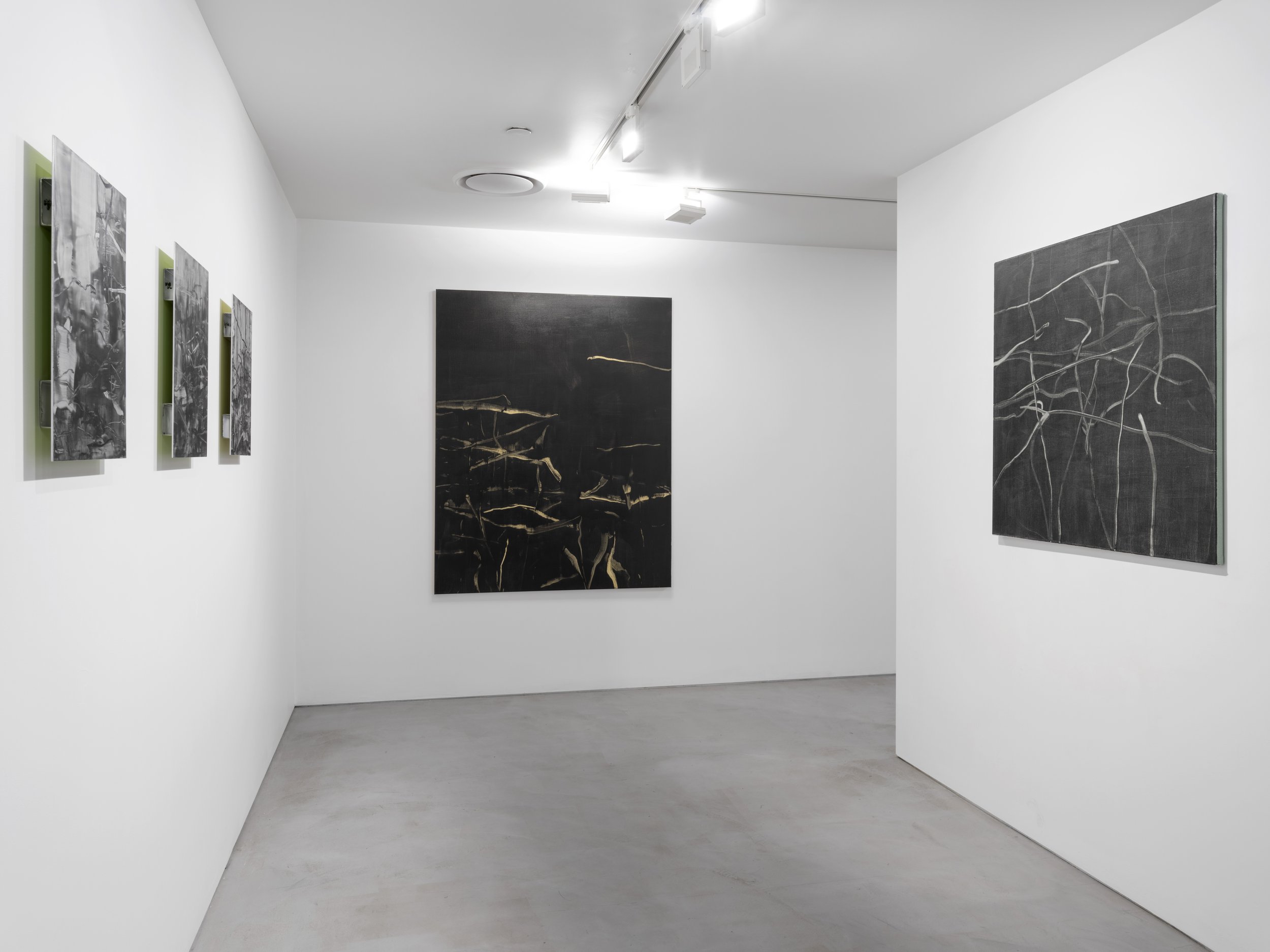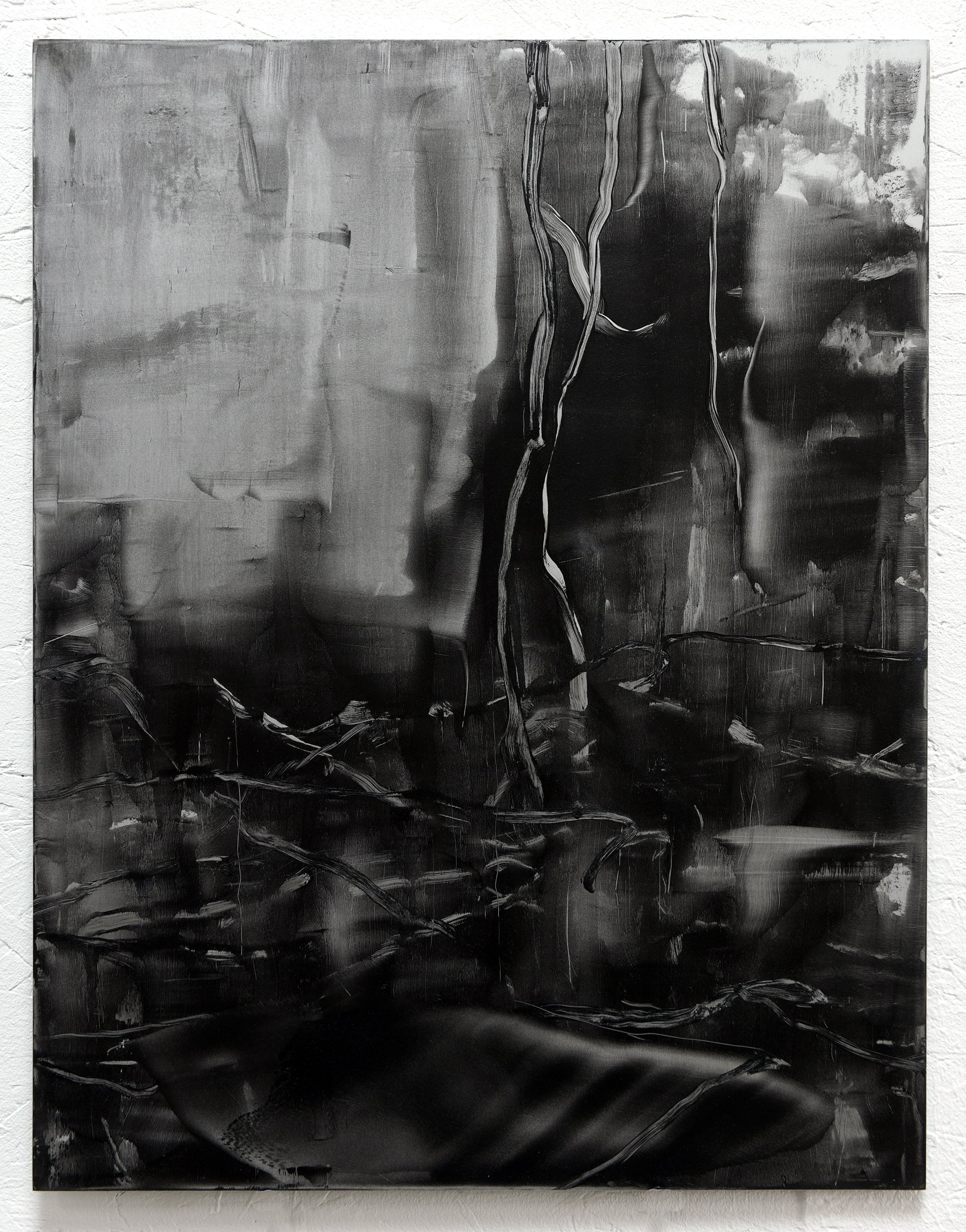GRAPHEMISM
https://issuu.com/janmantonart/docs/miles_hall_graphemism_online_catalogue
Graphemism (neologism): originating from the greek GRPAHIA (γραφία) “to draw, write, describe, record” and PHEME (ϕάναι) "to speak".
In the early 16C a tree was blown over in a storm in the Borrowdale region of Cumberland, England. Beneath its roots, an unfamiliar, soft grey-black rock was found. Fascinated by its slightly greasy metallic-grey permanence, the local farmers started using the rock to mark and identify their sheep. Centuries later the mineral substance would be synonymous with the history of drawing and visual thought. Subsequently termed ‘graphite’ in 1789 by the German scientist Abraham Gottlob, after the greek word γραφειν (graphia) “to write”, this soft mineral became the cornerstone of the pencil. Interestingly, graphite also occurs in meteorites.
Graphite holds the distinction of being the most stable form of solid carbon ever discovered and forms the basis for these new paintings. Its etymological ties to the history of drawing and writing confer the medium with a cultural significance that I have attempted to celebrate - notably the impulse to trace and elucidate existence through line.
Combining mineral, vegetable and animal, the graphite pigment is held in a medium of linseed oil and natural beeswax producing a paint rich in expressive potential. Using a range of both linen and aluminium supports, the works evolve from an active dialogue between material, gesture and surface. Paint is not considered as passive matter but an active element – its inherent properties contribute to the development and emergence of both form and content.
The use of line is central to the development of these paintings, specifically an open line that evokes elements of the natural world, growth and the enigma of creation. While the lines have an urge towards figuration, I aim to accentuate their abstract, tactile dimension – creating a union between the physical and pictorial experience of painting.
In addition to graphite, I have employed mica crystal glazes along with gold and silver pigments for chromatic impact. Depending on their relation to space, architecture, light and the observer, the surface of the works change considerably and aim to celebrate the physical dimension of painting in a dematerialised, digitalized world.
Miles Hall
Montpellier 10 June 2022

GRAPHEMISM // AURIFEROUS HEATH, Graphite & gold pigment with oil & beeswax on Belgian linen. 150x120cm, 2022.


GRAPHEMISM // OVER THE DEAD LEAVES, Graphite & gold pigment with oil & beeswax on Belgian linen. 150x120cm, 2022.


GRAPHEMISM // GREEN MILK, Graphite & mica crystal pigment with oil & beeswax on Belgian linen. 150x120cm, 2022.

GRAPHEMISM // STELLAR BLUE, Graphite & mica crystal pigment with oil & beeswax on Belgian linen. 150x120cm, 2022.

GRAPHEMISM // ROYAL VIOLET, Graphite, Gold & mica crystal pigment with oil & beeswax on Belgian linen. 150x120cm, 2022.


GRAPHEMISM // LIQUID EVENING, Graphite & mica crystal pigment with oil & beeswax on Belgian linen. 150x120cm, 2022.

GRAPHEMISM // AMOGNST ROCK AND WATER, Graphite pigment with oil & beeswax on Belgian linen. 150x150cm, 2022.


GRAPHEMISM // NOCTURNAL ELEGANCE, Graphite pigment with oil & beeswax on Belgian linen. 90x90cm, 2022.

GRAPHEMISM // DAMP EARTH, crystal pigment with oil & beeswax on Belgian linen. 90x90cm, 2022.


GRAPHEMISM // TWILLIGHT GARDEN, Graphite & mica crystal pigment with oil & beeswax on Belgian linen. 50x50cm, 2022.


GRAPHEMISM // CREPESCULE, Graphite & mica crystal pigment with oil & beeswax on Belgian linen. 50x50cm, 2022.

GRAPHEMISM // PENUMBRA GREEN, Graphite & mica crystal pigment with oil & beeswax on Belgian linen. 30x30cm, 2022.

GRAPHEMISM // DAMP EARTH II, Graphite & mica crystal pigment with oil & beeswax on Belgian linen. 30x30cm, 2022.

GRAPHEMISM // FORMATION I, Graphite pigment with oil & beeswax on anodised aluminium panel. 46x36cm, 2022.

GRAPHEMISM // FORMATION II, Graphite pigment with oil & beeswax on anodised aluminium panel. 46x36cm, 2022.

DETAIL


GRAPHEMISM // FORMATION III, Graphite pigment with oil & beeswax on anodised aluminium panel. 46x36cm, 2022.

GRAPHEMISM // FORMATION IV, Graphite pigment with oil & beeswax on anodised aluminium panel. 46x36cm, 2022.


GRAPHEMISM // FORMATION V, Graphite pigment with oil & beeswax on anodised aluminium panel. 46x36cm, 2022.

GRAPHEMISM // FORMATION VI, Graphite pigment with oil & beeswax on anodised aluminium panel. 46x36cm, 2022.



GRAPHEMISM // FORMATION VII, Graphite pigment with oil & beeswax on anodised aluminium panel. 46x36cm, 2022.

GRAPHEMISM

DETAIL

GRAPHEMISM // FORMATION VII, Graphite pigment with oil & beeswax on anodised aluminium panel. 46x36cm, 2022.

